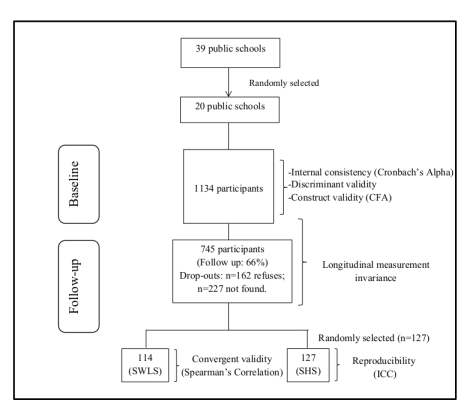-
Home
-
About JCTR
-
Gold Open Access
-
Issues
-
Editorial board
-
Author guidelines
-
Publication fees
-
Online first
-
Special issues
-
News
-
Publication ethics
-
Partners
-
Submit your manuscript
-
Submit your review report
-
Editorial Office
-

This work is licensed under a Creative Commons Attribution-NonCommercial 4.0 International License. ISSN print: 2382-6533 ISSN online: 2424-810X
Volume 7 issue 2
Psychometric properties and longitudinal measurement invariance of the Brazilian version of the subjective happiness scale in adolescents
Fernanda Ruffo Ortiz*, Saul Martins Paiva, Isabela Almeida Pordeus, Thiago Machado Ardenghi
Ortiz et al. J Clin Transl Res 2021; 7(2):4
Published online: March 16, 2021
Abstract
Background. Happiness is a subjective construct. Validation studies to confirm validity and reliability of happiness measures are needed to verify its applicability in research and clinical fields.
Aim. The aim of this study was to test the psychometric properties and longitudinal measurement invariance of the Subjective Happiness Scale (SHS) in adolescents.
Methods. A longitudinal study was conducted with a random sample of 1,134 12-year-old adolescents from Santa Maria, a southern city in Brazil, starting in 2012. Two years later, 746 adolescents were reassessed, with an average age of 14. The Brazilian version of the SHS, which is composed of four items, was administered by a face-to-face interview. Reliability (Cronbach’s alpha), reproducibility (intraclass correlation coefficient - ICC), discriminant validity; confirmatory factor analysis (CFA), convergent validity and measurement invariance (MI) were performed through the multi-group confirmatory factor analysis. Socioeconomic, clinical and subjective variables were also collected through clinical exams and structured questionnaires by calibrated and trained dentists.
Results. Cronbach’s alpha and ICC results were moderate (0.51 and 0.70, respectively). The scale was able to discriminate subjective happiness between different oral health groups and socioeconomic status. The CFA revealed a good fit model in both collections, confirming the validity of the scale. Convergent validity was satisfactory, demonstrating that the SHS is similar in theoretical concepts with a subjective scale. Moreover, MI showed a goodness-of-fit statistics across time points.
Conclusions. The Brazilian version of SHS showed adequate validation properties and longitudinal measurement among adolescents.
Relevance for patients. These findings are important for studies that evaluate happiness and oral disorders, through cross-section and longitudinal studies

DOI: http://dx.doi.org/10.18053/jctres.07.202102.004
Author affiliation
1. Department of Stomatology – Universidade Federal de Santa Maria, Brazil
2. Department of Pediatric Dentistry – Universidade Federal de Minas Gerais, Brazil
*Corresponding author
Fernanda Ruffo Ortiz
Department of Stomatology – Universidade Federal de Santa Maria. Av. Roraima, 1000, Prédio 26F, Camobi - 97105-900, Santa Maria, RS, Brasil.
Email: fernandaruffoortiz@gmail.com
Handling editor:
Michal Heger
Department of Pharmaceutics, Utrecht University, the Netherlands
Department of Pharmaceutics, Jiaxing University Medical College, Zhejiang, China

